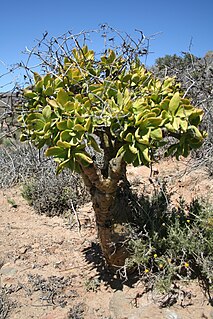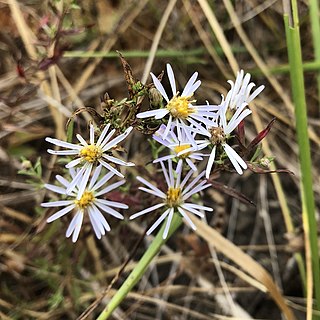
Isopyrum is a genus of flowering plants of the family Ranunculaceae native to Eurasia. The North American genus Enemion is sometimes treated as part of it.

Podocarpus laetus is a species of conifer in the family Podocarpaceae, commonly known as Hall's tōtara, mountain tōtara or thin-barked tōtara. Previously known as Podocarpus hallii and Podocarpus cunninghamii, in 2015 it was realised that the much earlier name P. laetus has priority. Its common name results from the species being named after J. W. Hall, a New Zealand pharmacist.
Achyrocline hallii is a species of flowering plant in the family Asteraceae. It is found only in Ecuador. Its natural habitats are subtropical or tropical moist montane forests and subtropical or tropical high-altitude shrubland. It is threatened by habitat loss.
Gynoxys hallii is a species of flowering plant in the family Asteraceae. It is found only in Ecuador. Its natural habitat is subtropical or tropical moist montane forests. It is threatened by habitat loss.
Astridia is a genus of plants in the family Aizoaceae. It is named after the wife Astrid of the German botanist and archaeologist Gustav Schwantes.

Helicia is a genus of 110 species of trees and shrubs, constituting part of the plant family Proteaceae. They grow naturally in rainforests throughout tropical South and Southeast Asia, including India, Sri Lanka, Indochina, Peninsular Malaysia to New Guinea and as far south as New South Wales.
Huernia hallii is a species of plant in the family Apocynaceae. It is endemic to Namibia. Its natural habitat is rocky areas.

Tylecodon is a genus of succulent plants in the family Crassulaceae, native to southern Africa.
Caulanthus hallii is a species of flowering plant in the family Brassicaceae known by the common name Hall's wild cabbage.
Columbiadoria is a small North American genus of flowering plants in the daisy family.
Harmonia hallii is a species of flowering plant in the aster family known by the common names Hall's harmonia and Hall's madia.

Andropogon hallii is a sod-forming perennial species in the grass family, Poaceae. It is a bunchgrass which grows in tufts and can reach 7 feet in height under favorable conditions.

The World's 25 Most Endangered Primates is a list of highly endangered primate species selected and published by the International Union for Conservation of Nature (IUCN) Species Survival Commission (SSC) Primate Specialist Group (PSG), the International Primatological Society (IPS), Global Wildlife Conservation (GWC), and Bristol Zoological Society (BZS). The IUCN/SSC PSG worked with Conservation International (CI) to start the list in 2000, but in 2002, during the 19th Congress of the International Primatological Society, primatologists reviewed and debated the list, resulting in the 2002–2004 revision and the endorsement of the IPS. The publication was a joint project between the three conservation organizations until the 2012–2014 list when BZS was added as a publisher. The 2018–2020 list was the first time Conservation International was not among the publishers, replaced instead by GWC. The list has been revised every two years following the biannual Congress of the IPS. Starting with the 2004–2006 report, the title changed to "Primates in Peril: The World's 25 Most Endangered Primates". That same year, the list began to provide information about each species, including their conservation status and the threats they face in the wild. The species text is written in collaboration with experts from the field, with 60 people contributing to the 2006–2008 report and 85 people contributing to the 2008–2010 report. The 2004–2006 and 2006–2008 reports were published in the IUCN/SSC PSG journal Primate Conservation,, since then they have been published as independent publications.

Tetracoccus hallii is a species of flowering shrub in the family Picrodendraceae, known by the common names Hall's shrubby-spurge and Hall's tetracoccus.

Schoenoplectiella hallii is a species of flowering plant in the sedge family known by the common name Hall's bulrush. It is native to the United States, where it has a disjunct distribution, occurring in widely spaced locations throughout the Midwest and East. It is a rare plant.
Astridia dinteri is a species of plant in the family Aizoaceae. It was named in 1961.

Symphyotrichum hallii is a species of flowering plant in the family Asteraceae endemic to western Oregon and Washington states. Commonly known as Hall's aster, it is a perennial, herbaceous plant with a long rhizome that creates colonies of itself. It grows about 30–60 centimeters tall, and has white rays that open July–August.
Malacothamnus hallii is a species of flowering plant in the mallow family known by the common name Hall's bushmallow. It is endemic to southeastern counties of the San Francisco Bay Area, where it is a rare species. It has a California Rare Plant Rank of 1B.2. Malacothamnus hallii is occasionally treated within Malacothamnus fasciculatus.









